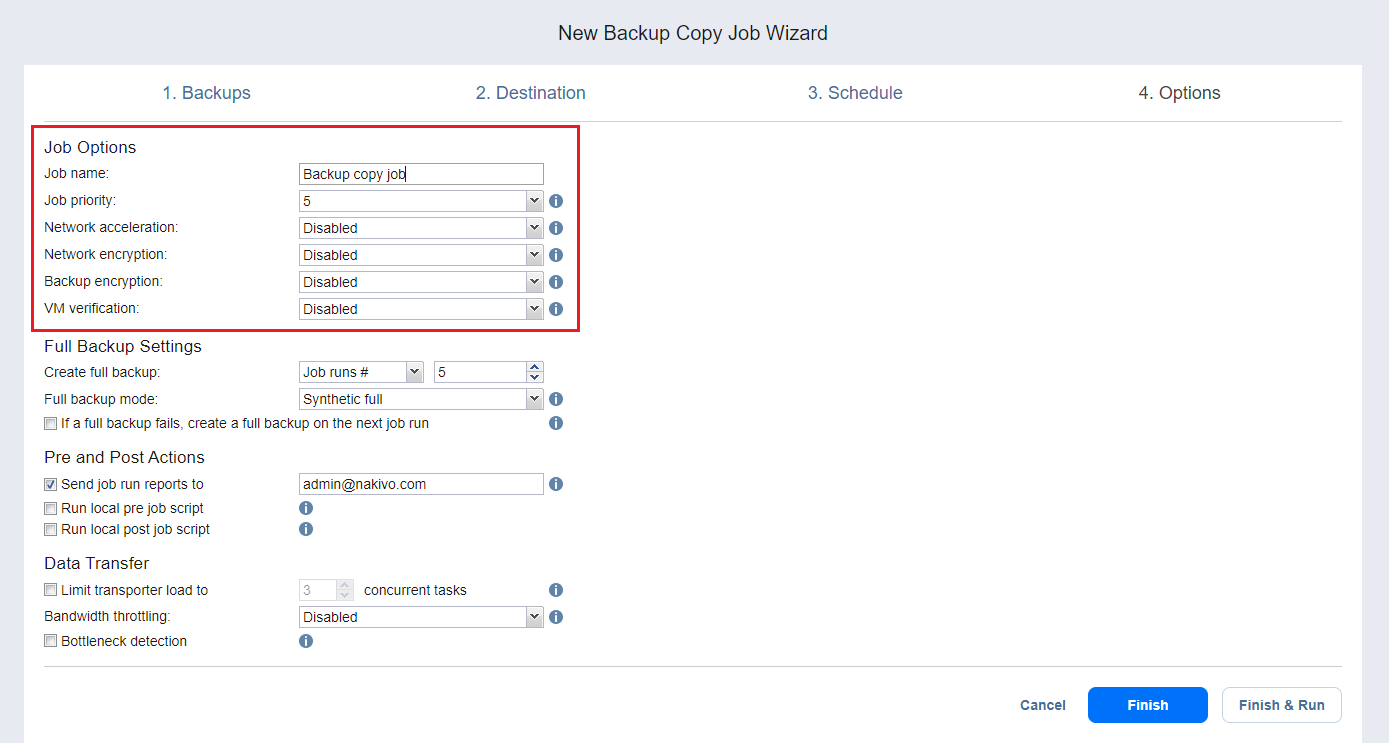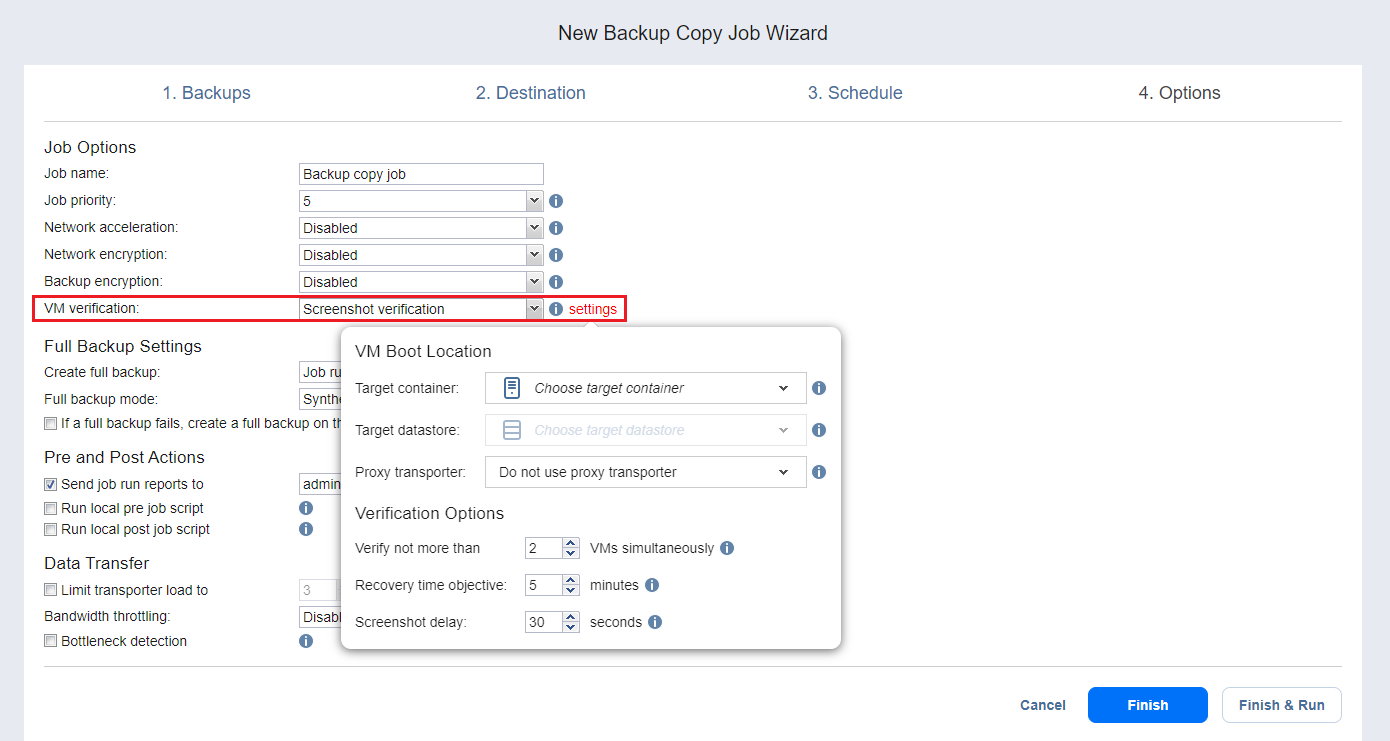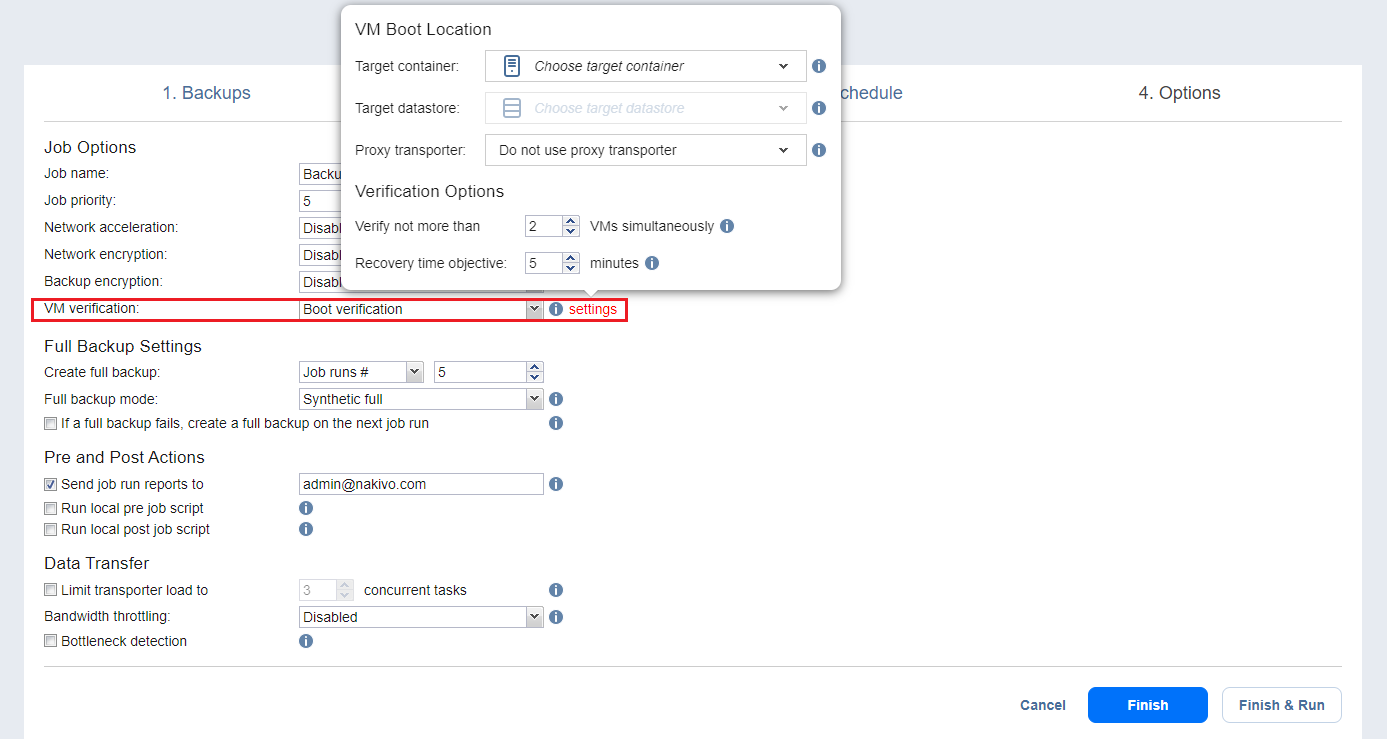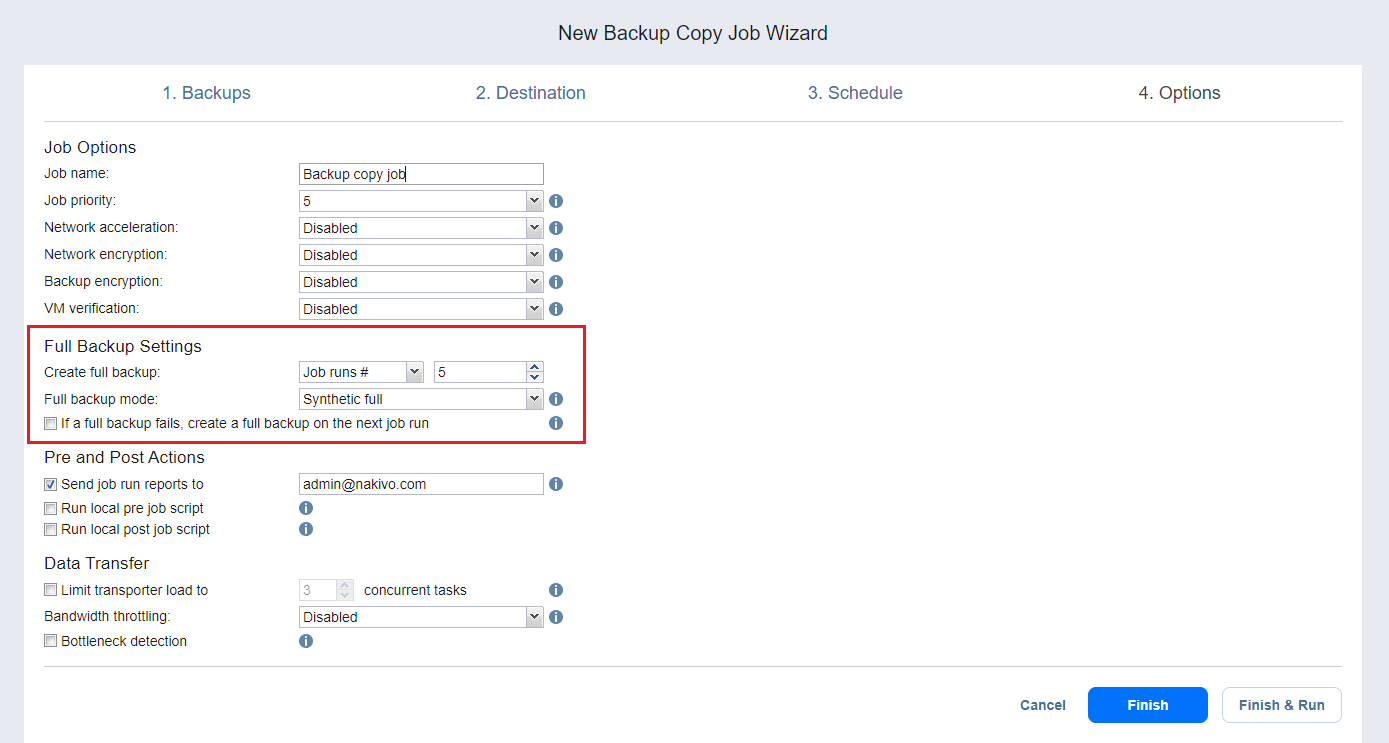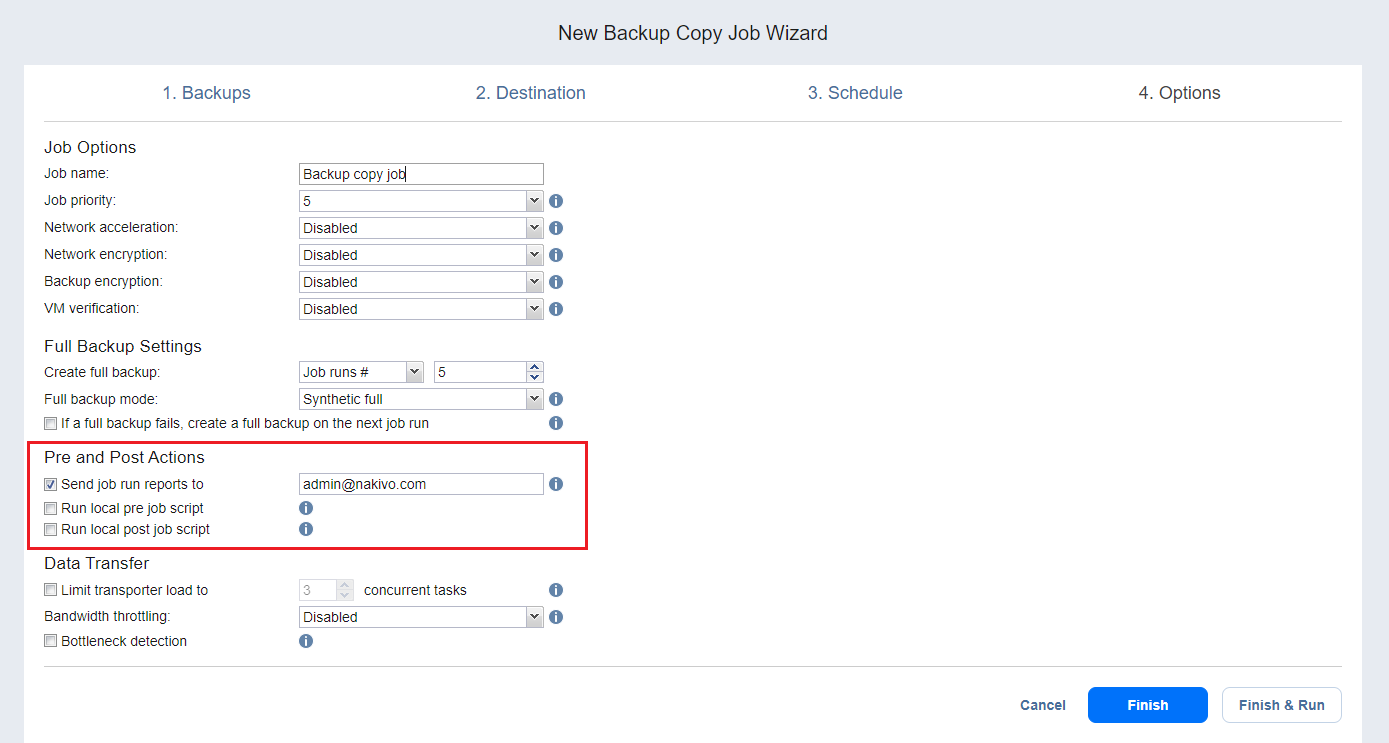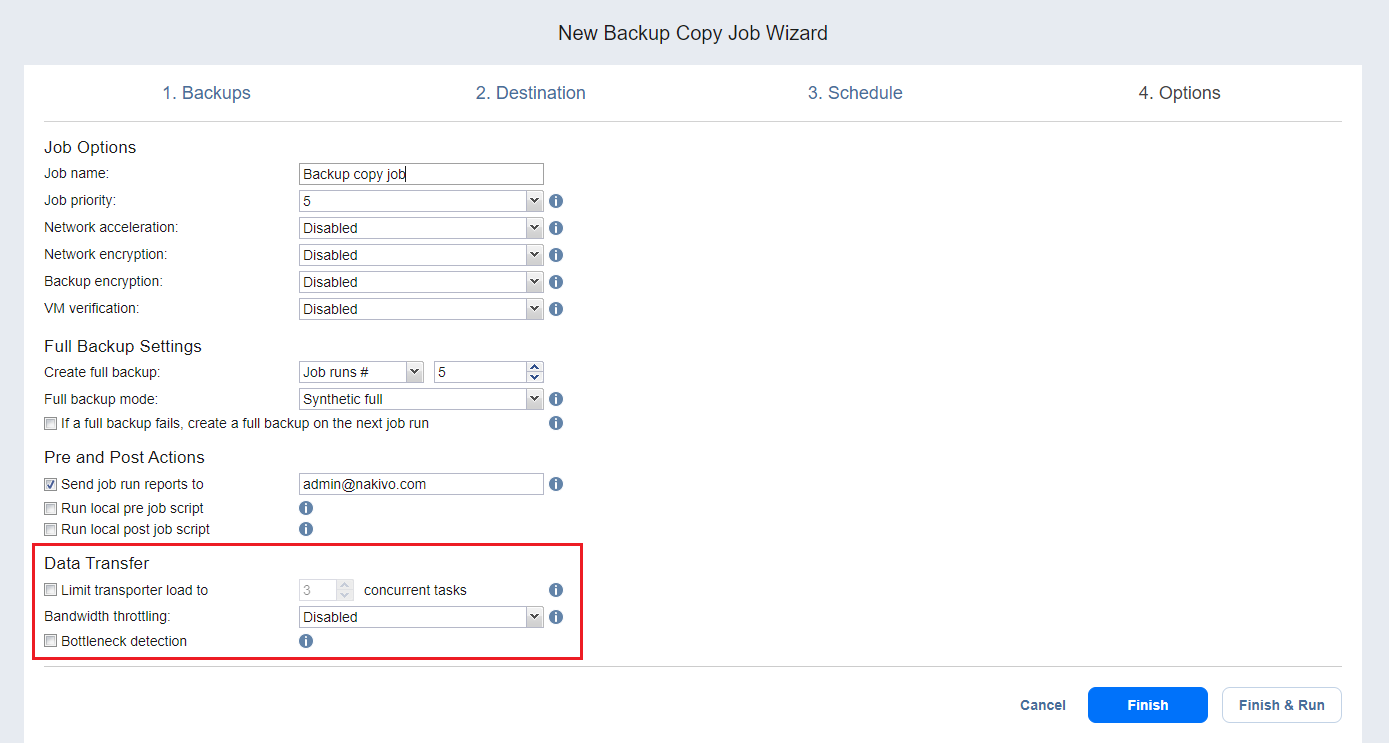Backup Copy Job Wizard: Options
On the Options page of the wizard, you can set up job options. Proceed as described in these sections:
- Job Options
- Full Backup Settings
- Pre and Post Actions
- Data Transfer
- Completing the New Backup Copy Job Wizard
Note
If multiple backup types are selected during Backups step, including a Microsoft 365 backup, options that are not supported for Microsoft 365 backups become disabled.
If a file-level backup job is selected at the Backups step, the VM Verification option is unavailable.
Job Options
In this section, you can give a name to the backup copy job and enable/disable network acceleration, change tracking, set encryption and VM Verification. Proceed as described below.
Job Name
Specify a name for the backup copy job in the Job Name box.
Job Priority
Select a job priority level between 1 and 5, with 1 being the highest priority. Jobs with higher priority levels are prioritized by Transporters during job processing.
Note
This option is only available in the Enterprise, Enterprise Essentials, Enterprise Plus, MSP Enterprise, and MSP Enterprise Plus editions.
Network Acceleration
If network acceleration is enabled, NAKIVO Backup & Replication uses compression and traffic reduction techniques to speed up data transfer. Select this option if you plan to back up over WAN or slow LAN links.
Note
The Network acceleration option is not available if the Backup encryption option is enabled.
Network Encryption
If the Network Encryption option is selected, backup data will be protected with AES 256 encryption while traveling over the network. Data encryption increases the backup time and CPU load on machines running Transporters. Select this option if you are backing up over WAN without a VPN connection.
Note
You need at least one Transporter at the source and target sites to enable network encryption.
Backup Encryption
When enabled, backup data is protected with AES 256 block cipher encryption with a 256-bit key length.
The following three options are available:
-
Disabled (default)
-
Enabled on source: If enabled, the single-time-use AES key is passed to the Transporter which reads the source data
-
Enabled on target: If enabled, the single-time-use AES key is passed to the Transporter which writes the data to target
You can protect the backup file by creating a new password or selecting an existing one. For more information, refer to Enabling Backup Encryption.
Notes
Backup encryption is available only if the Disk or Tape destination type was chosen on the Destination page of the wizard.
The Backup encryption dropdown is disabled if the Network acceleration option is enabled.
The Backup encryption options cannot be enabled if all source backups are encrypted or multiple targets where supported and unsupported (SaaS repositories and forever incremental) repositories are selected as destinations.
The Backup encryption options are not displayed for a backup job where forever incremental repositories are selected as the only target repositories.
You cannot copy the encrypted recovery points for which no corresponding password hash is available.
It’s recommended that you enable the (AWS) Key Management Service. If KMS is enabled, all backup encryption passwords encrypted with the Key Management Service cryptographic key are available for recovery in case of product re-installation. For more information, refer to Enabling KMS.
VM Verification
VM Verification allows you to check the integrity of the backup by starting it and interacting with it. For more details, refer to VM Verification
You can choose one of the following VM verification options:
-
Disabled: VM verification is disabled.
-
Screenshot verification: When enabled, all VM backups created by the job are verified: After a backup of a VM is completed, the VM will be recovered from the backup using Flash boot (and will be disconnected from networks) and a screenshot of the recovered VM will be taken once the VM OS has booted, after which the VM will be discarded. VM screenshots will be included in email notifications (if they’re configured) and displayed on the Dashboard.
-
Boot verification: When enabled, all VM backups created by the job are verified as follows. After a VM backup is completed, NAKIVO Backup & Replication recovers the VM using Flash boot, disables networking to prevent network connections, and verifies that system start is successful.
After choosing Screenshot verification, provide the following information in the dialog box that opens:
-
Provide a location of the VMs that need to be booted:
-
Target Container: Choose a target container (cluster, host, or resource pool) where VMs will be run using Flash boot.
-
Target Datastore: Choose a datastore that will host changes to the recovered VMs.
-
Proxy transporter: Choose a proxy transporter from the list of available Transporters.
Note
NAKIVO Backup & Replication will use a proxy Transporter in the following cases:
The Transporter assigned to the Backup Repository cannot use iSCSI port 3260 because it is occupied by other services.
iSCSI packages are missing on the Transporter assigned to the Backup Repository. -
-
Set verification options:
-
Verify not more than X VMs simultaneously: Specify the maximum number of VMs that can be started on the Target Container simultaneously.
-
Recovery time objective: Specify the amount of time allocated for the verification of each VM backup. If a VM OS does not start within the specified amount of time, verification will be considered failed.
-
Screenshot delay: The amount of time that the product should wait after the guest OS starts before taking a screenshot.
The specified time must be sufficient to fully start the VM OS. Try increasing this amount if the default amount is not sufficient.
-
After selecting Boot verification, do the following in the dialog box that opens:
-
Provide the location of the VMs to be booted as described for the Screenshot verification option.
-
Set verification options:
-
Verify not more than x VMs simultaneously: Specify the maximum number of VMs that can be started on the Target Container simultaneously.
-
Recovery time objective: Specify the amount of time allocated for verification of each VM backup. If a VM OS does not start within the specified amount of time, verification will be considered failed.
-
Full Backup Settings
If the type of the Backup Repository that you selected on the Destination page is set to Incremental with full backups (Store backups in separate files option is selected), you can specify the following options:
-
Create full backup: Specify how often full backups should be created.
-
Full backup mode: Specify how the full backup should be created. You can choose between the following options:
-
Synthetic full: If this option is selected, NAKIVO Backup & Replication will first perform an incremental backup (that is, will transfer only the data that changed since the last backup) and will then transform the available data into a full backup file. This approach has the following benefits:
-
The synthetic full backup is usually faster than the active full backup.
-
The load on the network is lower, as less data is transferred.
-
The load on the source datastores running your production VMs is lower.
-
-
Active full: If this option is selected, NAKIVO Backup & Replication will read all data from the source and transfer it to the Backup Repository.
-
-
If a full backup fails, create a full backup on the next job run: With this option selected, the next job run creates a full backup if the current job run fails to do so.
Pre and Post Actions
NAKIVO Backup & Replication allows you to set up certain actions before a backup copy job begins and after it has completed. You can choose to send job run reports to the email provided and run local pre and post job scripts.
Email Notifications
NAKIVO Backup & Replication can send email notifications on job completion status to specified recipients. This feature complements global notifications and provides you with the ability to configure notifications on a per-job level.
To enable this option, configure your Email settings.
To send email notifications, do the following:
-
In the Pre and Post Actions section, select the Send job run reports to option.
-
Specify one or more email addresses in the text box. Separate multiple email addresses with a semicolon.
Pre Job Script
To run a script before the product begins copying backups, do the following:
-
Place a script file on the machine where the Director is installed.
-
In the Pre and Post Actions section, select the Run local pre job script option and click the settings link. Specify the following parameters in the dialog box that opens:
- Script path: Specify a local path to the script on the machine where the Director is installed. Script interpreter should be specified.
- Example (Windows): cmd.exe /c D:\script.bat
- Example (Linux): bash /root/script.sh
-
Job behavior: Choose either of the following job behaviors in relation to script completion:
-
Wait for the script to finish: If this option is selected, the backup copy will not be started until the script is completed.
-
Do not wait for the script to finish: If this option is selected, the product will run the script and will start copying backups at the same time.
-
-
Error handling: Choose either of the following job behaviors in relation to script failure:
-
Continue the job on script failure: If this option is selected, the job will perform backup copy even if the script has failed.
-
Fail the job on script failure: If this option is selected and the script fails, the job will be failed and the backup copy will not be performed.
-
Post Job Script
To run a script after the product has finished copying all backups, do the following:
-
Place a script file on the machine on which the Director is installed.
-
In the Pre and Post Actions section, select the Run local post job script option and click the settings link. Specify the following parameters in the dialog box that opens:
- Script path: Specify a local path to the script on the machine on which the Director is installed. Script interpreter should be specified.
- Example (Windows): cmd.exe /c D:\script.bat
- Example (Linux): bash /root/script.sh
- Job behavior: Choose either of the following job behaviors in relation to script completion:
- Wait for the script to finish: If this option is selected, the job will be in the “running” state until the script is completed.
- Do not wait for the script to finish: If this option is selected, the job will be completed even if the script execution is still in progress.
-
Error handling: Choose either of the following job behaviors in relation to script failure.
-
Continue the job on script failure: If this option is selected, script failure will not influence the status of the job.
-
Fail the job on script failure: If this option is selected and the script has failed, the job status will be set to “failed” even if VM backup has been successful.
-
Notes
Pre- and post-job scripts can be executed only on the machine on which the Director is installed.
When Integration Services are used on Hyper-V 2016 and above, custom pre/post scripts are unavailable for Windows VMs.
Data Transfer
In the Data Transfer section of the Options page, you can specify a Transporter load and configure bandwidth throttling.
Transporter Load
You can limit the maximum number of Transporter tasks used by the job. By default, it is set to 3 concurrent tasks.
To change the default number of tasks, do the following:
-
In the Data Transfer section, select the Limit transporter load to checkbox.
-
Specify the number of concurrent tasks in the corresponding box.
Bandwidth Throttling
Follow the steps below to regulate the speed of data transfer over the network for your backup copy job:
-
For the Bandwidth throttling option, choose Enabled.
Note
If bandwidth throttling is disabled for the current job, global bandwidth rules may still apply to your job. -
Click the settings link that becomes available.
-
The Job Bandwidth Rules dialog box opens displaying you the list of available rules. You have the following options:
-
Create a new bandwidth rule for your backup copy job:
-
Click the Create New Rule button.
-
The New Bandwidth Rule dialog box opens. Refer to Bandwidth Throttling for details on creating a bandwidth rule.
-
Click Save.
-
-
Activate an existing bandwidth rule for your job. Select the checkbox to the left of the necessary bandwidth rule. To deactivate a bandwidth rule for your job, clear the corresponding checkbox.
-
Edit a bandwidth rule. Click the Edit link for a bandwidth rule and modify it in the Edit Bandwidth Rule dialog box that opens.
-
Disable a bandwidth rule. Click the Disable link. The bandwidth rule will be disabled for all jobs.
-
Remove a bandwidth rule. Click the Remove link and then click Delete to confirm your operation.
-
Bottleneck detection
When the Bottleneck detection option is enabled, additional information is collected and recorded in NAKIVO Backup & Replication logs in the course of data transfer for the purpose of bottleneck detection. Check this option to enable the Bottleneck detection capability of the Transporters engaged in the job.
Note
This option is available only if the Disk destination type was chosen on the Destination page of the wizard.
Completing the New Backup Copy Job Wizard
Click Finish or Finish & Run to complete the job creation.
Note
If you click Finish & Run, you will have to define the scope of your job. Please refer to Running Jobs on Demand for details.
